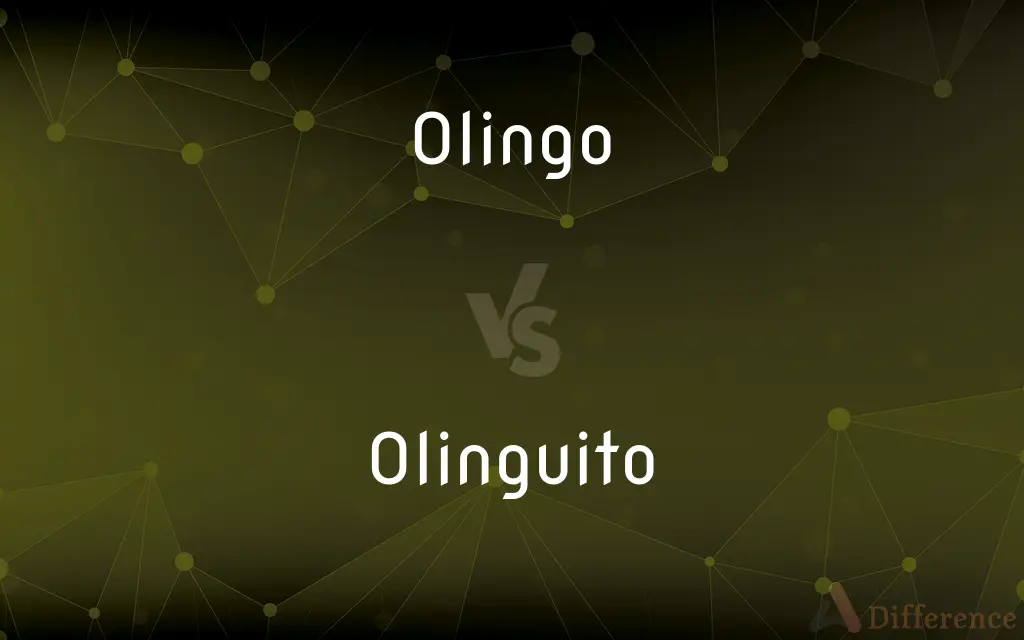Olingo vs. Olinguito — What's the Difference?
By Urooj Arif & Maham Liaqat — Updated on April 23, 2024
The olingo is a nocturnal tree-dwelling mammal of the raccoon family, known for its omnivorous diet, whereas the olinguito is a recently discovered smaller relative of the olingo, notable for being mainly frugivorous.

Difference Between Olingo and Olinguito
Table of Contents
ADVERTISEMENT
Key Differences
Olingos are found in Central and South America, typically in arboreal habitats and exhibit a more generalized diet that includes fruits, insects, and small animals. In contrast, the olinguito, also native to the cloud forests of the Andes, primarily eats fruits, making it more specialized in its feeding habits.
The olingo has a more widespread distribution, thriving in various forested environments from Nicaragua to Peru. On the other hand, the olinguito is known for its more limited range in the cloud forests of Colombia and Ecuador, highlighting its vulnerability and the importance of its specific habitat.
Olingos are larger with a grayer fur, longer limbs, and a less bushy tail compared to the olinguito. The olinguito distinguishes itself with a denser, reddish-brown fur, shorter limbs, and a bushier tail, adaptations that perhaps suit its colder, high-altitude environment.
The discovery of the olinguito in 2013 marked it as the first new carnivore species found in the Americas in 35 years, emphasizing the olinguito’s significance in biodiversity and conservation efforts. Whereas olingos have been well-known but are less highlighted in conservation statuses despite facing similar environmental threats.
Olingos are known to be solitary and highly territorial animals. The olinguito shares this solitary nature but is noted for its particularly shy and elusive behavior, which contributed to its late scientific discovery despite being in a relatively biodiverse and studied region.
ADVERTISEMENT
Comparison Chart
Diet
Omnivorous: fruits, insects, small animals
Mainly frugivorous (fruits)
Habitat
Broad range in Central and South America forests
Cloud forests in the Andes, more limited range
Physical Appearance
Larger, gray fur, longer limbs
Smaller, reddish-brown fur, bushier tail
Discovery
Well-known species
Discovered in 2013, highlighting new biodiversity
Conservation Status
Less prominent in conservation efforts
Critical for conservation due to limited range
Compare with Definitions
Olingo
A nocturnal arboreal mammal related to raccoons, with a grayish coat and native to Central and South America.
We spotted an olingo during our night hike in the rainforest.
Olinguito
A small, recently discovered mammal in the raccoon family, native to the Andean cloud forests.
The olinguito is one of the newest mammals described by science.
Olingo
Known for its agile climbing and omnivorous diet.
The olingo climbed swiftly from tree to tree in search of food.
Olinguito
Primarily frugivorous, it is adapted to a high-altitude, colder climate.
The diet of the olinguito consists mostly of the fruits found in its mountainous habitat.
Olingo
Found in a variety of forest ecosystems.
Olingos are a common sight in both the cloud forests and lowland rainforests.
Olinguito
Shy and elusive, contributing to its late identification.
The elusive nature of the olinguito kept it hidden from biologists for many years.
Olingo
Part of the Procyonidae family, which includes raccoons and coatis.
The olingo, like its cousin the raccoon, exhibits a great deal of adaptability.
Olinguito
Smaller and with more distinctively colored fur than its relatives.
The reddish-brown fur of the olinguito makes it easily distinguishable from the olingo.
Olingo
Solitary and territorial in nature.
The olingo we observed seemed very protective of its space against other tree-dwellers.
Olinguito
Its discovery highlighted the ongoing biodiversity in the Andean regions.
The find of the olinguito shows that even well-explored areas hold unknown wildlife secrets.
Olingo
Any of several small, nocturnal, chiefly arboreal mammals of the genus Bassaricyon of Central and South America, having a pointed snout and a long bushy tail.
Olinguito
The olinguito (Bassaricyon neblina) is a mammal of the raccoon family Procyonidae that lives in montane forests in the Andes of western Colombia and Ecuador. It was classified as belonging to a new species in 2013.
Olingo
A small procyonid resembling the kinkajou, native to the rainforests of Central and South America.
Olinguito
A small, arboreal, carnivorous mammal, Bassaricyon neblina, of northern Andean rainforests, having a pointed snout, thick brownish fur, and a long bushy tail. It is closely related to but smaller than the olingos.
Olinguito
Bassaricyon neblina, a raccoon-like procyonid native to the Andean forests of Colombia and Ecuador.
Common Curiosities
Why was the olinguito only discovered recently?
The olinguito's shy and elusive nature, combined with its habitat in dense Andean cloud forests, made it difficult for scientists to discover until 2013.
How do the habitats of olingos and olinguitos differ?
Olingos inhabit a broader range of forest environments across Central and South America, while olinguitos are mostly found in the cloud forests of the Andes.
Can olingos and olinguitos interbreed?
There is no known evidence of interbreeding; they are distinct species adapted to different ecological niches.
How do the physical characteristics of olingos and olinguitos differ?
Olingos are larger with grayer, less dense fur, while olinguitos are smaller with reddish-brown, bushier fur.
What role does the discovery of the olinguito play in scientific research?
The discovery of the olinguito has significant implications for biodiversity studies and emphasizes the need for continued exploration and conservation in tropical forests.
Are olingos and olinguitos endangered?
While specific conservation statuses vary, both face threats from habitat destruction and fragmentation.
What conservation efforts are in place for olinguitos?
Conservation efforts for olinguitos focus on protecting their limited and specific cloud forest habitats.
How do locals perceive olingos and olinguitos?
Local perceptions can vary, but generally, awareness and appreciation of these species are important for their protection.
What is the primary difference in diet between the olingo and the olinguito?
The olingo has an omnivorous diet including fruits, insects, and small animals, while the olinguito primarily consumes fruits.
How does the climate of the olinguito's habitat affect its behavior and diet?
The colder, high-altitude climate of the Andean cloud forests influences the olinguito’s dietary preference for fruits and its elusive, nocturnal behavior.
How can studies on olingos and olinguitos aid in broader wildlife conservation?
Studying these species helps understand ecosystem dynamics and can guide broader conservation strategies that benefit multiple species within their habitats.
What adaptations help olingos and olinguitos in their respective environments?
Olingos are adapted to a variety of forest environments with their agile climbing abilities, while olinguitos have adaptations like dense fur for the colder climate of higher altitudes.
What can be done to help preserve the habitats of olingos and olinguitos?
Protecting forest habitats from deforestation, promoting sustainable land use, and supporting local and international conservation initiatives are crucial steps.
Why are olingos less highlighted in conservation compared to olinguitos?
The olinguito’s recent discovery and limited range heighten its conservation priority, whereas the olingo, being more widespread, has received relatively less focused conservation attention.
What are the main threats to the survival of the olinguito?
Habitat destruction and climate change are major threats to the olinguito’s survival.
Share Your Discovery

Previous Comparison
Scary vs. Eerie
Next Comparison
Deduction vs. InductionAuthor Spotlight
Written by
Urooj ArifUrooj is a skilled content writer at Ask Difference, known for her exceptional ability to simplify complex topics into engaging and informative content. With a passion for research and a flair for clear, concise writing, she consistently delivers articles that resonate with our diverse audience.
Co-written by
Maham Liaqat














































